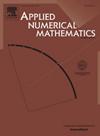大型数据集三角曲线的快速交替拟合方法
IF 2.2
2区 数学
Q1 MATHEMATICS, APPLIED
引用次数: 0
摘要
本文讨论并开发了根据平面上的数据点拟合圆、椭圆和哑铃等三角函数曲线的新方法。现有的圆或椭圆拟合方法对数据中的异常值非常敏感,而且在数据点数量较多时非常耗时。本文重点研究在数据点数量较多时具有吸引力的曲线拟合方法。我们提出了一种直接拟合圆的方法,以及两种基于三角多项式拟合椭圆和哑铃曲线的迭代方法。这些方法能有效地最小化给定数据点与拟合曲线之间的几何距离平方和。特别是,我们对探测星系或星云等天体的一般形状很感兴趣。某些星云,例如实验部分所示的星云,具有哑铃状的形状。文献中还没有讨论过拟合哑铃曲线的方法。所开发的方法对数据点的误差并不十分敏感。本文还讨论了使用数据点随机子采样来加快计算速度的问题。本文开发的技术也可用于拟合其他类型的曲线。本文章由计算机程序翻译,如有差异,请以英文原文为准。
Fast alternating fitting methods for trigonometric curves for large data sets
This paper discusses and develops new methods for fitting trigonometric curves, such as circles, ellipses, and dumbbells, to data points in the plane. Available methods for fitting circles or ellipses are very sensitive to outliers in the data, and are time consuming when the number of data points is large. The present paper focuses on curve fitting methods that are attractive to use when the number of data points is large. We propose a direct method for fitting circles, and two iterative methods for fitting ellipses and dumbbell curves based on trigonometric polynomials. These methods efficiently minimize the sum of the squared geometric distances between the given data points and the fitted curves. In particular, we are interested in detecting the general shape of an object such as a galaxy or a nebula. Certain nebulae, for instance, the one shown in the experiment section, have a dumbbell shape. Methods for fitting dumbbell curves have not been discussed in the literature. The methods developed are not very sensitive to errors in the data points. The use of random subsampling of the data points to speed up the computations also is discussed. The techniques developed in this paper can be applied to fitting other kinds of curves as well.
求助全文
通过发布文献求助,成功后即可免费获取论文全文。
去求助
来源期刊

Applied Numerical Mathematics
数学-应用数学
CiteScore
5.60
自引率
7.10%
发文量
225
审稿时长
7.2 months
期刊介绍:
The purpose of the journal is to provide a forum for the publication of high quality research and tutorial papers in computational mathematics. In addition to the traditional issues and problems in numerical analysis, the journal also publishes papers describing relevant applications in such fields as physics, fluid dynamics, engineering and other branches of applied science with a computational mathematics component. The journal strives to be flexible in the type of papers it publishes and their format. Equally desirable are:
(i) Full papers, which should be complete and relatively self-contained original contributions with an introduction that can be understood by the broad computational mathematics community. Both rigorous and heuristic styles are acceptable. Of particular interest are papers about new areas of research, in which other than strictly mathematical arguments may be important in establishing a basis for further developments.
(ii) Tutorial review papers, covering some of the important issues in Numerical Mathematics, Scientific Computing and their Applications. The journal will occasionally publish contributions which are larger than the usual format for regular papers.
(iii) Short notes, which present specific new results and techniques in a brief communication.
 求助内容:
求助内容: 应助结果提醒方式:
应助结果提醒方式:


